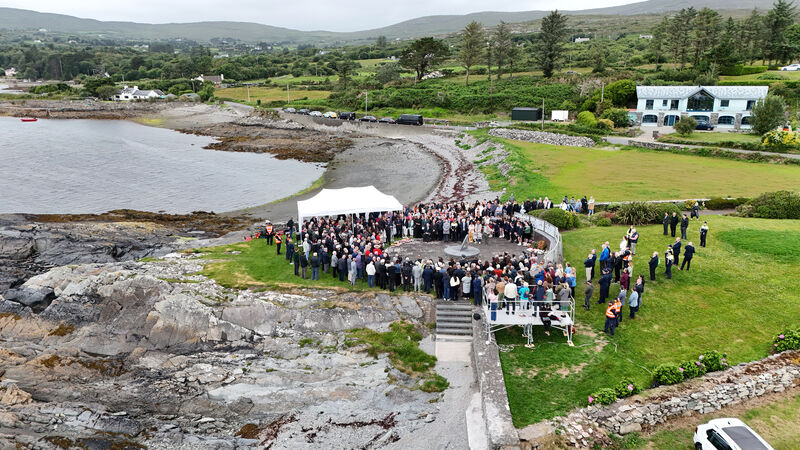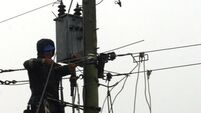'We need closure at some point': West Cork marks 40th anniversary of Air India disaster

A memorial service was held at the Air India 182 Memorial Garden in Ahakista on the Sheep's Head peninsula, West Cork, to mark the 40th anniversary of the Air India disaster. Picture: Dan Linehan
Families placed wreaths on the water at Ahakista on Monday morning after a moving ceremony to mark the 40th anniversary of the Air India explosion which killed 329 people.
A bomb placed on board Flight 182 by militants exploded off the Kerry/West Cork coast on June 23, 1985, with the plane plunging into the Atlantic.
The flight was due to stop over in London’s Heathrow before travelling to India for stops in Delhi and Mumbai. Passengers were primarily from Canada, but others on board came from India and Britain, as well as other countries. More than 80 of them were children.
More than 30 relatives travelled to West Cork for the ceremony organised by Cork County Council — including Narayana and Padmini Turlapati who lost two sons on the flight and have travelled to West Cork regularly since 1985, and Sanjay Lazar, whose parents, three-year-old sister and unborn sibling were lost in the tragedy.

Mr Lazar, who has written a book on the tragedy, told the he escaped the tragedy because he remained at home to study for exams. He recalled receiving a call to travel to London to meet with his father, but on arriving there, he discovered his family had been killed.
He then travelled to West Cork to wait anxiously for news of their remains being found. However, only his mother’s body was found. He said he found out after an autopsy on his mother’s remains that she was four months pregnant with his second sibling.
He saw photos of naval officers holding a cabbage patch doll, which he says was his sister’s.
“I have been struggling to get it for the last 40 years but it has not been possible. That is all I have — memories and this beautiful memorial,” he said.
“It was difficult. Ironically, I joined Air India the next year — flying for 38 years as a cabin crew member. I became a lawyer because of this.
“I have been an advocate for this case. I came here about four or five years ago and suddenly got an epiphany here. I feel close to my family here. I felt my dad was telling me I had not done enough. I was a trade union leader in India and I felt he felt I did not use my voice enough to promote against terrorism or speak for justice so I gave up my job.”
He has now published a book called about the bombing.

“I am glad the RCMP (Royal Canadian Mounted Police) are still pursuing the matter. We need closure at some point. I would like to see it before I die. I want the people who did it to say they did it. That’s all. There is no revenge, there is no vengeance. It is about answers and we all want answers. And I want a memorial like this in India and a learning centre where we teach people what radicalism and terrorism is about.”
Two men accused of murder and conspiracy relating to the crash were found not guilty in March 2005.
It was alleged the bombing was plotted by Sikh extremists in Canada as revenge on India for its storming of Sikhism’s Golden Temple in Amritsar in 1984.
Speaking to the in Ahakista, Canadian minister for public safety Gary Anandasangaree said people were still looking for answers.
“Ultimately, the challenge is that as time goes, the ability to complete and charge and go through a legal process becomes more elusive. The frustration is clear.
“If any of us are in the shoes of a family member, what would we want? We wouldn’t want answers, we would want people held to account for what happened. That has not happened in this case.
“We don’t have the level of closure the families would rightfully desire.”
During the ceremony, Indian minister for petroleum and natural gas Hardeep Singh Puri described the explosion as a “stain on humanity” and said it had left scars which had not healed in 40 years.

Taoiseach Micheal Martin said: “We feel the tragic scale of the loss, when we see the faces and read the stories on the memorial here before us. Especially moving are the simple descriptions, ‘student’ or ‘child’ — so many young lives taken far too soon. While the scale of this tragedy is of international significance, we should not forget that it is an intensely personal tragedy.
"The loss and grief felt by you, the families and loved ones of the people who died that June morning in 1985, is deeply personal. One only needs to come here, on any year, and listen to you speak, witness you placing flowers into the sea, or laying wreaths, to understand how powerful that grief remains.”














